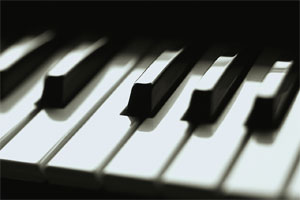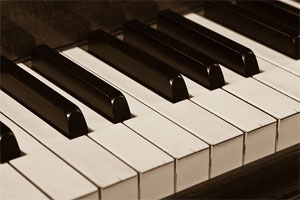There was a time when all pianos had ivory key tops.
By the middle of the 20th century, the use of plastic key tops began to replace ivory keys in a big way. Laws protecting elephants made ivory keys extremely rare in pianos built after the early 1970’s.

No pianos have ivory keys.
The keys of all pianos are made out of wood. It is only the thin top of the white keys which are made of ivory or plastic. The black keys are made of ebony. However, most Asian production pianos have plastic black keys. In this case, the entire key is made out of plastic and is hollow on the inside.
Growing up, my father had 2 grand pianos in his studio, an old Steinway with ivories, and a newer Baldwin with plastic key tops. I found the ivory to be slippery and the plastic offered a better grip on the keys. However, when I would perform in student recitals, it was quite the reverse. With a bit of nerves, the sweat in my hands made the plastic key tops slippery and the grip on the ivory much better.
Ivory key tops are porous.
So cleaning is more difficult than cleaning plastic key tops which can be cleaned with a high concentration rubbing alcohol; 90% or higher works best. You can use a soft cloth, paper towel, or cotton swabs made damp with the alcohol. Rub all the keys, black and white and you will be amazed at how much dirt comes off the keys. The high concentration of alcohol assures that the moisture will not compromise the integrity of the wooden keys. Ivory keys present a greater challenge. While cleaning with alcohol as above will work, in time it can dry out the ivory and cause warping. So it is best to use a slightly damp cloth with only water and use alcohol only when needed to remove persistent stains.

Ivory keys also will yellow in time.
You can help them keep white by not closing the fall board. While it is important to close the lid of the piano when not in use to avoid corrosion of the strings, the fall board only protects dust from settling on the keys which can be wiped off easily. If ivory key tops get too dirty or yellow, they can be polished and bleached. If a few are chipped or missing, some piano technicians have a large stock of replacements. This is no easy task since matching the exact size, color and texture of ivories is very challenging. Replacing key tops altogether with modern composite plastic key tops is not very expensive, 2 or 3 hundred dollars. Usually when doing this it is a good time to replace key bushings and front rail bushings which wear out. That can add another couple of hundred dollars.
So the question is…
which is better, ivory or plastic key tops?
I have run into many people who have a strong preference for one or the other. Many people prefer the mystique of real ivories on a beautifully restored vintage piano. Other people are horrified by the sacrifice of the animals to produce the ivory. Overall I would suggest if you have a piano with usable ivories, keep them in good shape as long as you can since they are nearly irreplaceable. A set of ivories can be procured but a set costs thousands of dollars. Keep in mind however that if you went out and bought a brand new Steinway grand piano, it would have plastic key tops. Functionally they are very close. Perhaps the texture of a good set of ivories gives a better grip particularly with sweaty hands. Otherwise it is not one of the more important considerations for a piano’s quality.








